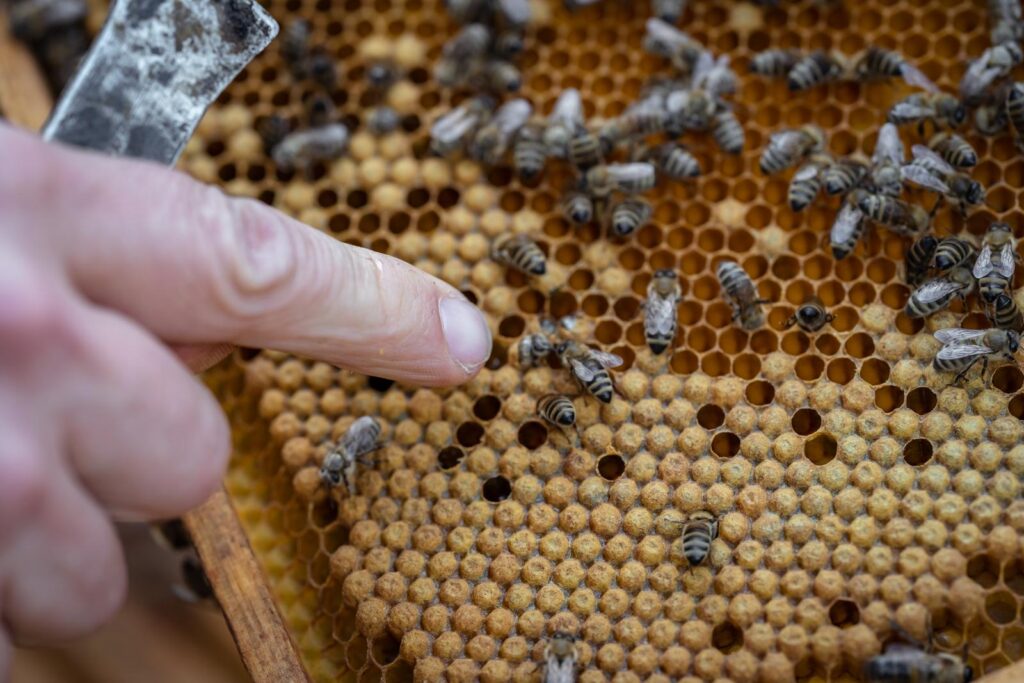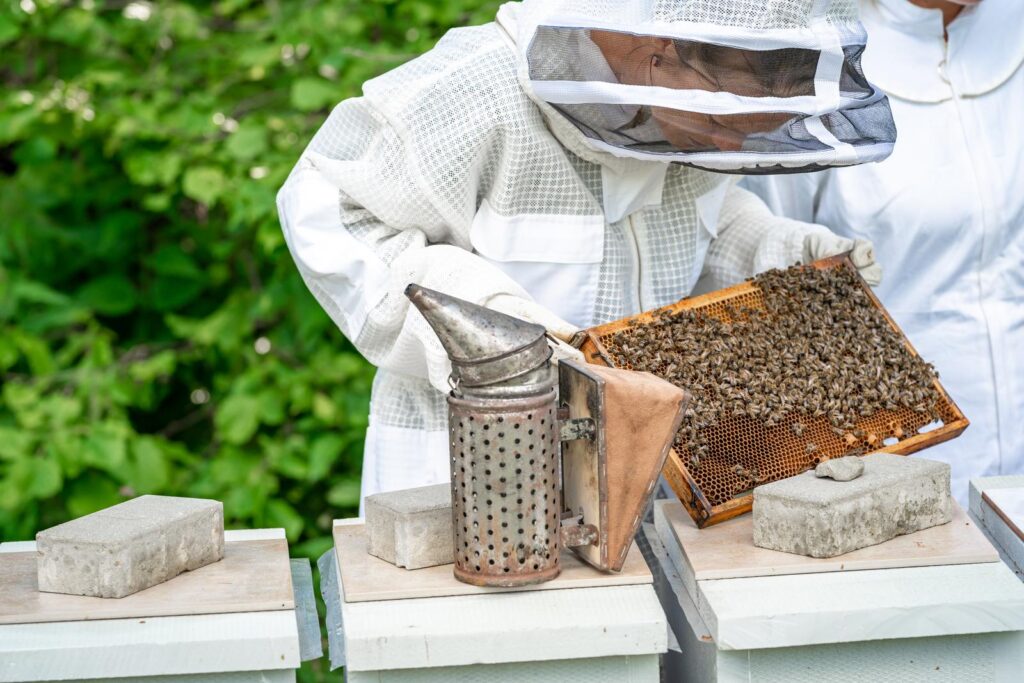Depending on why you’re reading this, be it in 2022 after years of covid-19 induced boredom activities that have finally run their course, out of sheer curiosity or maybe you’re looking for ways to help save the bees. This article intends to educate you on all you need to know before diving into the seemingly complicated world of beekeeping.
The internet is saturated with information that might feel overwhelming if you’re just starting out, so let’s break this down into a few bite-size Q&As (that’s “questions and answers” for my slang illiterate readers). These questions include what kind of beekeeping operation you might be interested in; whether beekeeping is affordable, profitable and whether beekeeping is safe …to name a few. Let’s begin!
1) “What is Beekeeping?”
Beekeeping is an age-old profession, known mainly as it is most often depicted on TV — as an activity involving people dressed in protective gear; cultivating swarming boxes of bees all to collect the primary by-product, honey. However, what you might not know is that beekeeping can involve a multitude of operations. Eva Crane in the Book “Encyclopaedia of Insects” lists a couple of other possibilities.
Some of these alternative types of beekeeping include the actual rearing of what is known as “package bees” as well as queens to produce honey. An alternative form of beekeeping supplies colonies of bees in some fields of large-scale agriculture where the native pollinators have been devastated and bees are needed to pollinate these crops.
Therefore, an essential element on your journey is deciding what type of beekeeping you are interested in. Different types of beekeeping will require different hives, different management and stimulation of bees, different space requirements and ultimately more time, more expertise, and more money.
This will all depend on what kind of bees you need to raise—for example, foragers to pollinate or young bees to make royal jelly. The specifics of this is perhaps the single most important consideration before stepping into this bu(zz)y world!
Once you have an idea of what type of beekeeping you are interested in, you can begin to ask your next question!
2) “Is Beekeeping Safe?”
One of your many concerns about joining the world of beekeeping might be, “Can I be stung?” or even “Is there a fatal risk involved with beekeeping?” Many people hold a justified fear of meeting the sharp end of an angry honeybee due to their stings (which we all know or have heard can be extremely painful.)
The science behind a bee sting explains that bee stings hurt for two reasons: firstly, the stinger is shaped like a barbed-wire sword that penetrates the skin and dislodges from the bee. Secondly, the stinger releases a chemical known as melittin, which then triggers pain receptors, triggering a burning sensation. The longer the stinger is left in, the more melittin it will release.
For most people, bee stings won’t cause more than a local reaction, affirms Thomas Arnold, MD at the Louisiana Poison Centre. This includes some discomfort, pain and maybe swelling and redness. The danger, however, is for the small group of people who are allergic to insect or bee stings and who may suffer a generalised reaction which may include difficulty breathing, hives (not the octagonal honey kind), loss of consciousness and may cause anaphylaxis or even death.
Up to 70 people die from allergic reactions to bee stings every year in the US, while tens of thousands have serious, although ultimately harmless reactions to stings. It is best to be tested for any allergies before starting as most fatalities happen with the first sting!
Therefore, beekeeping has the potential to be dangerous if you don’t know what you are doing; don’t have the right equipment for beekeepers and don’t wear the right protective clothing. (This is especially true if you’re allergic to these critters!) However, as Texan beekeeper Erika Thompson, popular on the social media app “TikTok” will tell you, bees are naturally gentle creatures. Despite the unavoidable risk of encountering the wrong bee at the wrong time, beekeeping can be a totally safe endeavour, so long as you know what you’re doing!
3) “How Affordable is Beekeeping?”
In today’s day and age, unless your name is Jeff Bezos, Bill Gates, or Oprah Winfrey, another necessary question you should be asking as a prospective hobbyist or alternatively as a newbie beekeeper intending to make a living is, “Is beekeeping economically feasible?” In layman’s terms, “How much capital will I need to become a beekeeper?”
An article titled, “How Much Does it Cost to Start Beekeeping? (Updated for 2022)” conveniently lists a minimum budget required to start up beekeeping for new-bee enthusiasts. Although calculated in US dollars ($), this article does provide a helpful baseline for those new to beekeeping who are looking to start their own colonies.
The total budget amount is given at approximately $760 for the first year of beekeeping. This total includes $270 towards the purchase of one set of hive components. An additional approximation $175 is allocated for a bee package. A further $165 is needed to cover protective gear and other necessary basic tools. Lastly, about $150 is allocated for miscellaneous costs for supplies and taxes. You can visit this article for a more in-depth breakdown of these costs.
These estimates are based on an analysis of the major online beekeeping websites. These estimates do not encompass shipping costs and the amount is subject to change depending on independent variables, such as how many bees you intend to keep, your location and obviously, your chosen beekeeping operation/what you intend to produce.
On the positive side of things, these amounts are only the initial costs to start up your beekeeping operation and cover the cost of items that will not need to be replaced for years. Moreover, maintenance costs are low and honeybees usually move freely and make use of available resources, meaning their food is usually free.
However, keep in mind that apart from start-up costs, there will be some upkeep costs as well as unexpected costs, like losing and needing to replace bees during the winter – which can be expensive.
There are of course many ways you can make money off beekeeping once set up and running. Bottling and selling your “homemade” honey is one option. Honey is a hot commodity that will likely sell well at your local street market or from a small home-based business. Another popular and profitable craft includes making and selling beeswax candles.
Selling these DIY goodies is an innovative way to fund or to profit off your beekeeping activities. More commercial or large-scale beekeepers can expect to earn healthy profits of upwards of $44,000 per year! You can read more about the profitability of beekeeping here.
4) “Can Beekeeping save the Bees?”
If your motivation behind wanting to begin your career as a beekeeper is fuelled by your inner nature activist, you might be wondering whether you can help “save the bees” by starting your own colony. Believe it or not, you can make a difference by keeping bees – and you don’t need to live on a farm to do it!
Bees are indeed essential to our natural environment and food production systems globally, yet the Global Citizen reports that beekeepers in both the US and Europe have confirmed annual colony losses of between 30% and 50% due to climate change, habitat losses and pesticide usage, to name a few. Our entire system relies on these pollinators, but luckily urban beekeeping has seen a rise in recent years.
Urban beekeeping literally means to keep bees in urban areas. Some great benefits of keeping bees in cities or towns include keeping bees away from the heavy pesticide and herbicide usage found in most agricultural areas today. Keeping bees near gardens or parks provides them with pesticide-free food and flowers to feast on.
This is as bees forage for floral resources from their surroundings, and not only from your yard/rooftop/farm. It is, however, important to consider your surrounding environment before introducing your colony of bees to an urban setting.
This is because some cities do not have sufficient resources to maintain even their own local honeybees. In these circumstances, it may be necessary to ensure that there are enough floral resources in your surroundings to support your bees, especially as bees are some of the quickest reproducing livestock!
You should also consider whether there are any regulations against keeping bees where you live and whether your neighbours are accepting of them or allergic. You should also consider whether your intended spot for your colony is safe and caters to the needs of the bees.
Apart from these considerations, long live the bees!
Conclusion:
Whether you are interested in commercial beekeeping, environmental activism or simply a new hobby, beekeeping is a forever growing industry. Beekeeping may be a bit pricy in terms of gathering all the necessary equipment when starting up, but bees don’t require much property and are not high maintenance.
Moreso, bee colonies produce a valuable commodity that sells well no matter where you are! While beekeeping certainly comes with its dangers, there are sufficient safety protocols in place to protect both you and the bees. Remember, do your research before keeping any animal, including bees!


